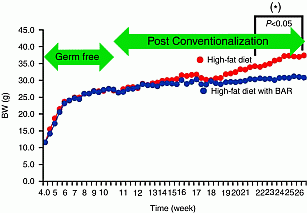ICEECE2012 Oral Communications Obesity Basic (6 abstracts)
Bile acid binding resin shows anti-obese effect through the modifications of intestinal microbiota
Y. Kusumoto 1 , J. Irie 1 , H. Tagawa 1 , A. Itoh 1 , M. Kato 1 , N. Kobayashi 1 , K. Tanaka 1 , S. Yamada 2 , T. Kawai 1 & H. Itoh 1
1Keio University School of Medicine, Shinjuku, Japan; 2Kitasato University Kitasato Institute Hospital, Minato, Japan.
The growing epidemic of obesity has led health professionals to understand the pathophysiology of obesity and its complications. Gut microbiota are of special interest, since some kinds of microbiota such as Bacteroides are less in obese persons and some microbiota induce obesity in animals by effective fat storage through microbiota-mediated intestinal Fiaf (Fasting-induced adipose factor) suppressions. Recently, bile acid-binding resins (BARs), non-absorbable drug for dyslipidemia, were reported to prevent obesity in rodents and humans, but the precise mechanisms and the effects to microbiota are unclear. Here we report the impact of BAR to gut microbiota and environments.
Six-week-old male BALB-c mice were fed standard diet, high-fat diet or high-fat diet with 1.5% of BAR (colestimide). Body compositions and gene expression were analyzed after 12-week treatment. The compositions of gut microbiota were studied by 16S rDNA analysis of cecal contents. The same procedures were performed under the germ-free conditions.
The administration of BAR significantly reduced the body weight and intra-abdominal fat gain (P<0.01). The decrease of gut Bacteroides and the increase of Clostridium in high-fat group were observed compared with normal diet, and the administration of BAR induced the increase of Bacteroides and the decrease of Clostridium (P<0.05). The intestinal fiaf expression decreased significantly with high-fat diet and increased significantly by BAR. These anti-obese effects of BAR disappeared under germ free conditions and the germ-free mice conventionalized with standard flora showed reduced body weight gain as shown in normal BAR-treated mice.
In conclusion, BAR has anti-obese effects through the changes of gut microbiota and environments. The modulation of gut microbiota by changing intestinal bile acid flux would be the novel therapeutic target for obesity.

Fig 1 BAR shows anti-obese effects through gut microbiota
Declaration of interest: The authors declare that there is no conflict of interest that could be perceived as prejudicing the impartiality of the research project.
Funding: This research did not receive any specific grant from any funding agency in the public, commercial or not-for-profit sector.




